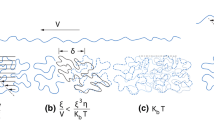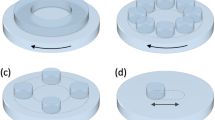Abstract
The surface sliding friction of chemically cross-linked poly(dimethyl siloxane) (PDMS) swollen with linear PDMS as an oligomer is investigated. The friction force f increases with the normal pressure P in a power-law relation f∝P α, where the exponent α changes in a range of 0-1, depending on the degree of polymerization, N poly, of the linear PDMS oligomer. When N poly is in a range of 240-320, a dramatic decrease in friction force is observed at a critical normal pressure, P c, leading to a very low friction coefficient on the order of 10−3 at high-pressure ranges. The P c increases with decreasing network size N netof the gel and also with increasing polymer length related to N poly. One possible explanation for this transition phenomenon in friction is that linear PDMS molecules are exuded from the gel network beyond a certain pressure and behave as polymer brushes, which are able to reduce the friction.
Similar content being viewed by others
References
J. P. Gong, M. Higa, Y. Iwasaki, Y. Katsuyama and Y. Osada, J. Phys. Chem. B 101 (1997) 5487.
J. P. Gong and Y. Osada, J. Chem. Phys. 109 (1998) 8062.
J. P. Gong, Y. Iwasaki, Y. Osada, K. Kurihara and Y. Hamai, J. Phys. Chem. B 103 (1999) 6001.
J. P. Gong, G. Kagata and Y. Osada, J. Phys. Chem. B 103 (1999) 6007.
J. P. Gong, Y. Iwasaki and Y. Osada, J. Phys. Chem. B 104 (2000) 3423.
J. P. Gong, T. Kurokawa, T. Narita, G. Kagata, Y. Osada, G. Nishimura and M. Kinjo, J. Am. Chem. Soc. 123 (2001) 5582.
G. Kagata, Y. Iwasaki, J. P. Gong and Y. Osada, J. Phys. Chem. B 106 (2002) 4596.
T. Kurokawa, J. P. Gong and Y. Osada, Macromolecules 35 (2002) 8161.
G. Kagata, J. P. Gong and Y. Osada, J. Phys. Chem. B 107 (2003) 10221.
K. Urayama, K. Yokoyama and S. Kohjiya, Macromolecules 34 (2001) 4513.
T. Kawamura, K. Urayama and S. Kohjiya, Macromolecules 34 (2001) 8252.
K. Urayama, T. Kawamura and K. Kohjiya, Macromolecules 34 (2001) 8261.
H. R. Brown, Science 263 (1994) 1411.
H. R. Brown, Faraday Discuss 98 (1994) 47.
B. N. J. Persson, Sliding Friction:Physical Principles and Applications, (Springer, New York, 1997).
D. F. Moore, Principles and Applications of Tribology, (Pergamon Press, Oxford, 1975).
Amonton-Coulomb's law: F=μ W, where F is the sliding friction and W is the normal load. By dividing both sides of F=μ W with the apparent contact area, we have f=μ P, which indicates that the friction in unit area f is proportional to the pressure P.
A. Shallamach, Wear 6 (1963) 375.
Rights and permissions
About this article
Cite this article
Tada, T., Kaneko, D., Gong, J.P. et al. Surface Friction of Poly(dimethyl Siloxane) Gel and Its Transition Phenomenon. Tribology Letters 17, 505–511 (2004). https://doi.org/10.1023/B:TRIL.0000044498.60673.76
Issue Date:
DOI: https://doi.org/10.1023/B:TRIL.0000044498.60673.76




